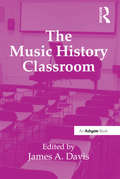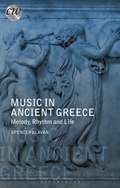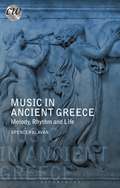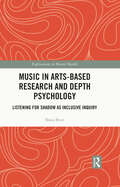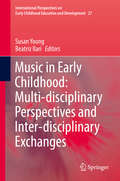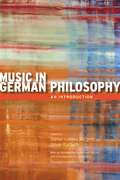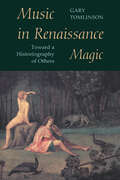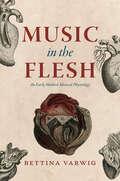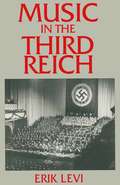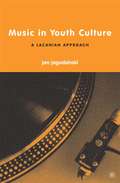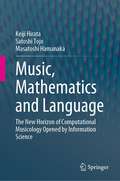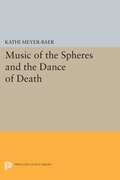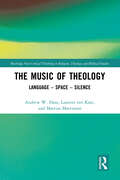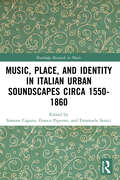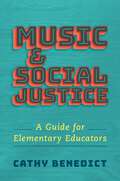- Table View
- List View
The Music History Classroom
by James A. DavisThe Music History Classroom brings together essays written by recognized and experienced teachers to assist in the design, implementation, and revision of college-level music history courses. This includes the traditional music history survey for music majors, but the materials presented here are applicable to other music history courses for music majors and general education students alike, including period classes, composer or repertory courses, and special topics classes and seminars. The authors bring current thought on the scholarship of teaching and learning together with practical experience into the unique environment of the music history classroom. While many of the issues confronting teachers in other disciplines are pertinent to music history classes, this collection addresses the unique nature of musical materials and the challenges involved in negotiating between historical information, complex technical musical issues, and the aesthetics of performing and listening. This single volume provides a systematic outline of practical teaching advice on all facets of music history pedagogy, including course design, classroom technology, listening and writing assignments, and more. The Music History Classroom presents the 'nuts-and-bolts' of teaching music history suitable for graduate students, junior faculty, and seasoned teachers alike.
The Music History Classroom
by James A. DavisThe Music History Classroom brings together essays written by recognized and experienced teachers to assist in the design, implementation, and revision of college-level music history courses. This includes the traditional music history survey for music majors, but the materials presented here are applicable to other music history courses for music majors and general education students alike, including period classes, composer or repertory courses, and special topics classes and seminars. The authors bring current thought on the scholarship of teaching and learning together with practical experience into the unique environment of the music history classroom. While many of the issues confronting teachers in other disciplines are pertinent to music history classes, this collection addresses the unique nature of musical materials and the challenges involved in negotiating between historical information, complex technical musical issues, and the aesthetics of performing and listening. This single volume provides a systematic outline of practical teaching advice on all facets of music history pedagogy, including course design, classroom technology, listening and writing assignments, and more. The Music History Classroom presents the 'nuts-and-bolts' of teaching music history suitable for graduate students, junior faculty, and seasoned teachers alike.
Music in Ancient Greece: Melody, Rhythm and Life (Classical World)
by Spencer KlavanLife in ancient Greece was musical life. Soloists competed onstage for popular accolades, becoming centrepieces for cultural conversation and even leading Plato to recommend that certain forms of music be banned from his ideal society. And the music didn't stop when the audience left the theatre: melody and rhythm were woven into the whole fabric of daily existence for the Greeks. Vocal and instrumental songs were part of religious rituals, dramatic performances, dinner parties, and even military campaigns. Like Detroit in the 1960s or Vienna in the 18th century, Athens in the 400s BC was the hotspot where celebrated artists collaborated and diverse strands of musical tradition converged. The conversations and innovations that unfolded there would lay the groundwork for musical theory and practice in Greece and Rome for centuries to come. In this perfectly pitched introduction, Spencer Klavan explores Greek music's origins, forms, and place in society. In recent years, state-of-the-art research and digital technology have enabled us to decipher and understand Greek music with unprecedented precision. Yet many readers today cannot access the resources that would enable them to grapple with this richly rewarding subject. Arcane technical details and obscure jargon veil the subject - it is rarely known, for instance, that authentic melodies still survive from antiquity, helping us to imagine the vivid soundscapes of the Classical and Hellenistic eras. Music in Ancient Greece distills the latest discoveries into vivid prose so readers can come to grips with the basics as never before. With the tools in this book, beginners and specialists alike will learn to hear the ancient world afresh and come away with a new, musical perspective on their favourite classical texts.
Music in Ancient Greece: Melody, Rhythm and Life (Classical World)
by Spencer KlavanLife in ancient Greece was musical life. Soloists competed onstage for popular accolades, becoming centrepieces for cultural conversation and even leading Plato to recommend that certain forms of music be banned from his ideal society. And the music didn't stop when the audience left the theatre: melody and rhythm were woven into the whole fabric of daily existence for the Greeks. Vocal and instrumental songs were part of religious rituals, dramatic performances, dinner parties, and even military campaigns. Like Detroit in the 1960s or Vienna in the 18th century, Athens in the 400s BC was the hotspot where celebrated artists collaborated and diverse strands of musical tradition converged. The conversations and innovations that unfolded there would lay the groundwork for musical theory and practice in Greece and Rome for centuries to come. In this perfectly pitched introduction, Spencer Klavan explores Greek music's origins, forms, and place in society. In recent years, state-of-the-art research and digital technology have enabled us to decipher and understand Greek music with unprecedented precision. Yet many readers today cannot access the resources that would enable them to grapple with this richly rewarding subject. Arcane technical details and obscure jargon veil the subject - it is rarely known, for instance, that authentic melodies still survive from antiquity, helping us to imagine the vivid soundscapes of the Classical and Hellenistic eras. Music in Ancient Greece distills the latest discoveries into vivid prose so readers can come to grips with the basics as never before. With the tools in this book, beginners and specialists alike will learn to hear the ancient world afresh and come away with a new, musical perspective on their favourite classical texts.
Music in Arts-Based Research and Depth Psychology: Listening for Shadow as Inclusive Inquiry (ISSN)
by Shara BrunThis book addresses an existing gap in academic arts-based research, whereby, rather than exploring music as an effective therapeutic intervention, it is explored as the central medium or tool of inquiry.Integrating heuristic, hermeneutic, and arts-based grounded theory methodologies, the book conceptualizes and describes the practice of Sonic Stretching as an in-depth example of using sound as an effective and systematic research tool. Stemming from evidence-based insights, the book explores and explains ways in which music and sound can be utilized in arts-based research (ABR) in all disciplines, as opposed to only being used among professional musicians and those operating within music studies. It points to some of the obstacles that have previously prevented this from happening more broadly and, in doing so, aims to help bridge the conspicuous gap in ABR studies, where music and sonic imagination should be.Offering a clear and well-presented example for integrating music and sound into processes of depth psychological inquiry and addressing the impact of colonialization upon embodied knowledge in music and academic research, it will appeal to scholars and researchers working at the intersection of psychology, music studies, education, social justice, and research methods.
Music in Arts-Based Research and Depth Psychology: Listening for Shadow as Inclusive Inquiry (ISSN)
by Shara BrunThis book addresses an existing gap in academic arts-based research, whereby, rather than exploring music as an effective therapeutic intervention, it is explored as the central medium or tool of inquiry.Integrating heuristic, hermeneutic, and arts-based grounded theory methodologies, the book conceptualizes and describes the practice of Sonic Stretching as an in-depth example of using sound as an effective and systematic research tool. Stemming from evidence-based insights, the book explores and explains ways in which music and sound can be utilized in arts-based research (ABR) in all disciplines, as opposed to only being used among professional musicians and those operating within music studies. It points to some of the obstacles that have previously prevented this from happening more broadly and, in doing so, aims to help bridge the conspicuous gap in ABR studies, where music and sonic imagination should be.Offering a clear and well-presented example for integrating music and sound into processes of depth psychological inquiry and addressing the impact of colonialization upon embodied knowledge in music and academic research, it will appeal to scholars and researchers working at the intersection of psychology, music studies, education, social justice, and research methods.
Music in Early Childhood: Multi-disciplinary Perspectives And Inter-disciplinary Exchanges (International Perspectives on Early Childhood Education and Development #27)
by Susan Young Beatriz IlariThis book examines four main areas of music in early childhood: the traditions of music for young children, their capacities for music, the way they make music with others, and constructed and mediated musical childhoods. It studies several themes in detail, including music making in the home and family life, various musical experiences in schools, day cares, and the community at large in several locations around the globe. It looks at technology and diverse musical repertoires, as well as innovative pedagogies, children’s agency, and brain research. Expanding on the knowledge bases on which early childhood music education typically draws, the book brings together contributions from a range of authors from diverse fields such as education, psychology, sociology, cultural studies, anthropology, philosophy, ethnomusicology, and the neurosciences. The end result is a volume that offers a broad and contemporary picture of music in early childhood.
Music in German Philosophy: An Introduction
by Stefan Lorenz Sorgner Oliver Fürbeth Susan H. GillespieThough many well-known German philosophers have devoted considerable attention to music and its aesthetics, surprisingly few of their writings on the subject have been translated into English. Stefan Lorenz Sorgner, a philosopher, and Oliver Fürbeth, a musicologist, here fill this important gap for musical scholars and students alike with this compelling guide to the musical discourse of ten of the most important German philosophers, from Kant to Adorno. Music in German Philosophy includes contributions from a renowned group of ten scholars, including some of today’s most prominent German thinkers, all of whom are specialists in the writers they treat. Each chapter consists of a short biographical sketch of the philosopher concerned, a summary of his writings on aesthetics, and finally a detailed exploration of his thoughts on music. The book is prefaced by the editors’ original introduction, presenting music philosophy in Germany before and after Kant, as well as a new introduction and foreword to this English-language addition, which places contemplations on music by these German philosophers within a broader intellectual climate.
Music in German Philosophy: An Introduction
by Stefan Lorenz Sorgner Oliver Fürbeth Susan H. GillespieThough many well-known German philosophers have devoted considerable attention to music and its aesthetics, surprisingly few of their writings on the subject have been translated into English. Stefan Lorenz Sorgner, a philosopher, and Oliver Fürbeth, a musicologist, here fill this important gap for musical scholars and students alike with this compelling guide to the musical discourse of ten of the most important German philosophers, from Kant to Adorno. Music in German Philosophy includes contributions from a renowned group of ten scholars, including some of today’s most prominent German thinkers, all of whom are specialists in the writers they treat. Each chapter consists of a short biographical sketch of the philosopher concerned, a summary of his writings on aesthetics, and finally a detailed exploration of his thoughts on music. The book is prefaced by the editors’ original introduction, presenting music philosophy in Germany before and after Kant, as well as a new introduction and foreword to this English-language addition, which places contemplations on music by these German philosophers within a broader intellectual climate.
Music in German Philosophy: An Introduction
by Stefan Lorenz Sorgner Oliver Fürbeth Susan H. Gillespie H. James Birx Michael SpitzerThough many well-known German philosophers have devoted considerable attention to music and its aesthetics, surprisingly few of their writings on the subject have been translated into English. Stefan Lorenz Sorgner, a philosopher, and Oliver Fürbeth, a musicologist, here fill this important gap for musical scholars and students alike with this compelling guide to the musical discourse of ten of the most important German philosophers, from Kant to Adorno. Music in German Philosophy includes contributions from a renowned group of ten scholars, including some of today’s most prominent German thinkers, all of whom are specialists in the writers they treat. Each chapter consists of a short biographical sketch of the philosopher concerned, a summary of his writings on aesthetics, and finally a detailed exploration of his thoughts on music. The book is prefaced by the editors’ original introduction, presenting music philosophy in Germany before and after Kant, as well as a new introduction and foreword to this English-language addition, which places contemplations on music by these German philosophers within a broader intellectual climate.
Music In Renaissance Magic: Toward A Historiography Of Others
by Gary TomlinsonMagic enjoyed a vigorous revival in sixteenth-century Europe, attaining a prestige lost for over a millennium and becoming, for some, a kind of universal philosophy. Renaissance music also suggested a form of universal knowledge through renewed interest in two ancient themes: the Pythagorean and Platonic "harmony of the celestial spheres" and the legendary effects of the music of bards like Orpheus, Arion, and David. In this climate, Renaissance philosophers drew many new and provocative connections between music and the occult sciences. In Music in Renaissance Magic, Gary Tomlinson describes some of these connections and offers a fresh view of the development of early modern thought in Italy. Raising issues essential to postmodern historiography--issues of cultural distance and our relationship to the others who inhabit our constructions of the past --Tomlinson provides a rich store of ideas for students of early modern culture, for musicologists, and for historians of philosophy, science, and religion. "A scholarly step toward a goal that many composers have aimed for: to rescue the idea of New Age Music--that music can promote spiritual well-being--from the New Ageists who have reduced it to a level of sonic wallpaper."--Kyle Gann, Village Voice "An exemplary piece of musical and intellectual history, of interest to all students of the Renaissance as well as musicologists. . . . The author deserves congratulations for introducing this new approach to the study of Renaissance music."--Peter Burke, NOTES "Gary Tomlinson's Music in Renaissance Magic: Toward a Historiography of Others examines the 'otherness' of magical cosmology. . . . [A] passionate, eloquently melancholy, and important book."--Anne Lake Prescott, Studies in English Literature
Music in the Flesh: An Early Modern Musical Physiology (New Material Histories of Music)
by Bettina VarwigA corporeal history of music-making in early modern Europe. Music in the Flesh reimagines the lived experiences of music-making subjects—composers, performers, listeners—in the long seventeenth century. There are countless historical testimonies of the powerful effects of music upon the early modern body; it is described as moving, ravishing, painful, dangerous, curative, and miraculous while affecting “the circulation of the humors, the purification of the blood, the dilation of the vessels and pores.” How were these early modern European bodies constituted that music generated such potent bodily-spiritual effects? Bettina Varwig argues that early modern music-making practices challenge our modern understanding of human nature as a mind-body dichotomy. Instead, they persistently affirm a more integrated anthropology, in which body, soul, and spirit remain inextricably entangled. Moving with ease across repertories and regions, sacred and vernacular musics, and domestic and public settings, Varwig sketches a “musical physiology” that is as historically illuminating as it is relevant for present-day performance. This book makes a significant contribution not just to the history of music, but also to the history of the body, the senses, and the emotions, revealing music as a unique access point for reimagining early modern modes of being-in-the-world.
Music in the Flesh: An Early Modern Musical Physiology (New Material Histories of Music)
by Bettina VarwigA corporeal history of music-making in early modern Europe. Music in the Flesh reimagines the lived experiences of music-making subjects—composers, performers, listeners—in the long seventeenth century. There are countless historical testimonies of the powerful effects of music upon the early modern body; it is described as moving, ravishing, painful, dangerous, curative, and miraculous while affecting “the circulation of the humors, the purification of the blood, the dilation of the vessels and pores.” How were these early modern European bodies constituted that music generated such potent bodily-spiritual effects? Bettina Varwig argues that early modern music-making practices challenge our modern understanding of human nature as a mind-body dichotomy. Instead, they persistently affirm a more integrated anthropology, in which body, soul, and spirit remain inextricably entangled. Moving with ease across repertories and regions, sacred and vernacular musics, and domestic and public settings, Varwig sketches a “musical physiology” that is as historically illuminating as it is relevant for present-day performance. This book makes a significant contribution not just to the history of music, but also to the history of the body, the senses, and the emotions, revealing music as a unique access point for reimagining early modern modes of being-in-the-world.
Music in the Third Reich
by Erik LeviIn this authoritative study, one of the first to appear in English, Erik Levi explores the ambiguous relationship between music and politics during one of the darkest periods of recent cultural history. Utilising material drawn from contemporary documents, journals and newspapers, he traces the evolution of reactionary musical attitudes which were exploited by the Nazis in the final years of the Weimar Republic, chronicles the mechanisms that were established after 1933 to regiment musical life throughout Germany and the occupied territories, and examines the degree to which the climate of xenophobia, racism and anti-modernism affected the dissemination of music either in the opera house and concert hall, or on the radio and in the media.
Music in Youth Culture: A Lacanian Approach
by j. jagodzinskiMusic in Youth Culture examines the fantasies of post-Oedipal youth cultures as displayed on the landscape of popular music from a post-Lacanian perspective. Jan Jagodzinski, an expert on Lacan, psychoanalysis, and education's relationship to media, maintains that a new set of signifiers is required to grasp the sliding signification of contemporary 'youth'. He discusses topics such as the figurality of noise, the perversions of the music scene by boyz/bois/boys and the hysterization of it by gurlz/girls/grrrls. Music in Youth Culture also examines the postmodern 'fan (addict)', techno music, and pop music icons. Jagodzinski raises the Lacanian question of 'an ethics of the Real' and asks educators to re-examine 'youth' culture.
Music, Mathematics and Language: The New Horizon of Computational Musicology Opened by Information Science
by Keiji Hirata Satoshi Tojo Masatoshi HamanakaThis book presents a new approach to computational musicology in which music becomes a computational entity based on human cognition, allowing us to calculate music like numbers. Does music have semantics? Can the meaning of music be revealed using symbols and described using language? The authors seek to answer these questions in order to reveal the essence of music. Chapter 1 addresses a very fundamental point, the meaning of music, while referring to semiotics, gestalt, Schenkerian analysis and cognitive reality. Chapter 2 considers why the 12-tone equal temperament came to be prevalent. This chapter serves as an introduction to the mathematical definition of harmony, which concerns the ratios of frequency in tonic waves. Chapter 3, “Music and Language,” explains the fundamentals of grammar theory and the compositionality principle, which states that the semantics of a sentence can be composed in parallel to its syntactic structure. In turn, Chapter 4 explains the most prevalent score notation – the Berklee method, which originated at the Berklee School of Music in Boston – from a different point of view, namely, symbolic computation based on music theory. Chapters 5 and 6 introduce readers to two important theories, the implication-realization model and generative theory of tonal music (GTTM), and explain the essence of these theories, also from a computational standpoint. The authors seek to reinterpret these theories, aiming at their formalization and implementation on a computer. Chapter 7 presents the outcomes of this attempt, describing the framework that the authors have developed, in which music is formalized and becomes computable. Chapters 8 and 9 are devoted to GTTM analyzers and the applications of GTTM. Lastly, Chapter 10 discusses the future of music in connection with computation and artificial intelligence.This book is intended both for general readers who are interested in music, and scientists whose research focuses on music information processing. In order to make the content as accessible as possible, each chapter is self-contained.
The Music of Sounds and the Music of Things: Sonic Creativity Within Sampling and DIY Cultures
by Leigh Landy John RichardsThis book investigates two areas in which the appreciation of sonic creativity can be easily acquired across diverse cultures, ages and interests: the music of sounds – making music with any sounds, part of today’s sampling culture and the music of things – and the creation of instruments using existent materials (another type of sampling?) involving the notion of ‘instrument as composition’ as part of today’s DIY (or DIT, do it together) culture.The book offers broad discussions regarding the music of things (written by John Richards) followed by the music of sounds (written by Leigh Landy). These chapters are followed by a focus on the workshop demonstrating the collaborative and inclusive potential in both areas, and a spotlight on eight artists with a broad diversity of backgrounds and approaches to sound and music who discuss their perceptions. The book’s conclusion focuses on similarities and differences between the music of sounds and the music of things, suggesting, finally, that both might form part of the 21st- century’s folk music landscape.The book is primarily aimed towards students interested in current forms of sonic creativity but will be of interest to those interested in broader issues of sampling culture, hacking and sound studies.
The Music of Sounds and the Music of Things: Sonic Creativity Within Sampling and DIY Cultures
by Leigh Landy John RichardsThis book investigates two areas in which the appreciation of sonic creativity can be easily acquired across diverse cultures, ages and interests: the music of sounds – making music with any sounds, part of today’s sampling culture and the music of things – and the creation of instruments using existent materials (another type of sampling?) involving the notion of ‘instrument as composition’ as part of today’s DIY (or DIT, do it together) culture.The book offers broad discussions regarding the music of things (written by John Richards) followed by the music of sounds (written by Leigh Landy). These chapters are followed by a focus on the workshop demonstrating the collaborative and inclusive potential in both areas, and a spotlight on eight artists with a broad diversity of backgrounds and approaches to sound and music who discuss their perceptions. The book’s conclusion focuses on similarities and differences between the music of sounds and the music of things, suggesting, finally, that both might form part of the 21st- century’s folk music landscape.The book is primarily aimed towards students interested in current forms of sonic creativity but will be of interest to those interested in broader issues of sampling culture, hacking and sound studies.
Music of the Spheres and the Dance of Death: Studies in Musical Iconology
by Kathi Meyer-BaerThe roots and evolution of two concepts usually thought to be Western in origin-musica mundana (the music of the spheres) and musica humana (music's relation to the human soul)-are explored. Beginning with a study of the early creeds of the Near East, Professor Meyer-Baer then traces their development in the works of Plato and the Gnostics, and in the art and literature of the Middle Ages and the Renaissance. Previous studies of symbolism in music have tended to focus on a single aspect of the problem. In this book the concepts of musica humana and musica mundane are related to philosophy, aesthetics, and the history of religion and are given a rightful place in the history of civilization.Originally published in 1970.The Princeton Legacy Library uses the latest print-on-demand technology to again make available previously out-of-print books from the distinguished backlist of Princeton University Press. These editions preserve the original texts of these important books while presenting them in durable paperback and hardcover editions. The goal of the Princeton Legacy Library is to vastly increase access to the rich scholarly heritage found in the thousands of books published by Princeton University Press since its founding in 1905.
The Music of Theology: Language – Space – Silence (Routledge New Critical Thinking in Religion, Theology and Biblical Studies)
by Andrew Hass Mattias Martinson Laurens ten KateThis book reconceives theology as a musical endeavour in critical tension with language, space and silence. An Overture first moves us from music to religion, and then from theology back to music – a circularity that, drawing upon history, sociology, phenomenology, and philosophy, disclaims any theology of music and instead pursues the music in theology. The chapters that follow explore the three central themes by way of theory, music and myth: Adorno, Benjamin and Deleuze (language), Derrida, Rosa and Nancy (space), Schelling/Hegel, Homer and Cage (silence). In overdubbing each other, these chapters work towards theology as a sonorous rhythm between loss and freedom. A Coda provides three brief musical examples – Thomas Tallis, György Ligeti, and Evan Parker – as manifestations of this rhythm, to show in summary how music becomes the very pulse of theology, and theology the very intuition of music. The authors offer an interdisciplinary engagement addressing fundamental questions of the self and the other, of humanity and the divine, in a deconstruction of modern culture and of its bias towards the eye over the ear. The book harmonizes three scholarly voices who attempt to find where the resonance of our Western conceptions and practice, musically and theologically, might resound anew as a more expansive music of theology.
The Music of Theology: Language – Space – Silence (Routledge New Critical Thinking in Religion, Theology and Biblical Studies)
by Andrew Hass Mattias Martinson Laurens ten KateThis book reconceives theology as a musical endeavour in critical tension with language, space and silence. An Overture first moves us from music to religion, and then from theology back to music – a circularity that, drawing upon history, sociology, phenomenology, and philosophy, disclaims any theology of music and instead pursues the music in theology. The chapters that follow explore the three central themes by way of theory, music and myth: Adorno, Benjamin and Deleuze (language), Derrida, Rosa and Nancy (space), Schelling/Hegel, Homer and Cage (silence). In overdubbing each other, these chapters work towards theology as a sonorous rhythm between loss and freedom. A Coda provides three brief musical examples – Thomas Tallis, György Ligeti, and Evan Parker – as manifestations of this rhythm, to show in summary how music becomes the very pulse of theology, and theology the very intuition of music. The authors offer an interdisciplinary engagement addressing fundamental questions of the self and the other, of humanity and the divine, in a deconstruction of modern culture and of its bias towards the eye over the ear. The book harmonizes three scholarly voices who attempt to find where the resonance of our Western conceptions and practice, musically and theologically, might resound anew as a more expansive music of theology.
Music, Place, and Identity in Italian Urban Soundscapes circa 1550-1860 (Routledge Research in Music)
by Simone Caputo Franco Piperno Emanuele SeniciMusic, Place, and Identity in Italian Urban Soundscapes circa 1550-1860 presents new perspectives on the role music played in the physical, cultural, and civic spaces of Italian cities from the sixteenth to the nineteenth century. Across thirteen chapters, contributors explore the complex connections between sound and space within these urban contexts, demonstrating how music and sound were intimately connected to changing social and political practices. The volume offers a critical redefinition of the core concept of soundscape, considering musical practices through the lenses of territory, space, representation, and identity, in five parts: Soundscape, Phonosphere, and Urban History Urban Soundscapes across Time Urban Soundscapes and Acoustic Communities Urban Soundscapes in Literary Sources Reconstructing Urban Soundscapes in the Digital Era Music, Place, and Identity in Italian Urban Soundscapes circa 1550-1860 reframes our understanding of Italian music history beyond models of patronage, investigating how sounds and musics have contributed to the construction of human identities and communities.
Music, Place, and Identity in Italian Urban Soundscapes circa 1550-1860 (Routledge Research in Music)
Music, Place, and Identity in Italian Urban Soundscapes circa 1550-1860 presents new perspectives on the role music played in the physical, cultural, and civic spaces of Italian cities from the sixteenth to the nineteenth century. Across thirteen chapters, contributors explore the complex connections between sound and space within these urban contexts, demonstrating how music and sound were intimately connected to changing social and political practices. The volume offers a critical redefinition of the core concept of soundscape, considering musical practices through the lenses of territory, space, representation, and identity, in five parts: Soundscape, Phonosphere, and Urban History Urban Soundscapes across Time Urban Soundscapes and Acoustic Communities Urban Soundscapes in Literary Sources Reconstructing Urban Soundscapes in the Digital Era Music, Place, and Identity in Italian Urban Soundscapes circa 1550-1860 reframes our understanding of Italian music history beyond models of patronage, investigating how sounds and musics have contributed to the construction of human identities and communities.
Music, Radio and the Public Sphere: The Aesthetics of Democracy
by Charles FairchildRadio, the most widely used medium in the world, is a dominant mediator of musical meaning. Through a combination of critical analysis, interdisciplinary theory and ethnographic writing about community radio, this book provides a novel theorization of democratic aesthetics, with important implications for the study of old and new media alike.
MUSIC & SOCIAL JUSTICE C: A Guide for Elementary Educators
by Cathy BenedictIn this book author Cathy Benedict challenges and reframes traditional ways of addressing many of the topics we have come to think of as social justice. Offering practical suggestions for helping both teachers and students think philosophically (and thus critically) about the world around them, each chapter engages with important themes through music making and learning as it presents scenarios, examples of dialogue with students, unit ideas and lesson plans geared toward elementary students (ages 6-14). Taken-for-granted subjects often considered beyond the understanding of elementary students such as friendship, racism, poverty, religion, and class are addressed and interrogated in such a way that honours the voice and critical thinking of the elementary student. Suggestions are given that help both teachers and students to pause, reflect and redirect dialogue with questions that uncover bias, misinformation and misunderstandings that too often stand in the way of coming to know and embracing difference. Guiding questions, which anchor many curricular mandates, are used throughout in order to scaffold critical and reflective thinking beginning in the earliest grades of elementary music education. Where does social justice reside? Whose voice is being heard and whose is being silenced? How do we come to think of and construct poverty? How is it that musics become used the way they are used? What happens to songs initially intended for socially driven purposes when their significance is undermined? These questions and more are explored encouraging music teachers to embrace a path toward socially just engagements at the elementary and middle school levels.
